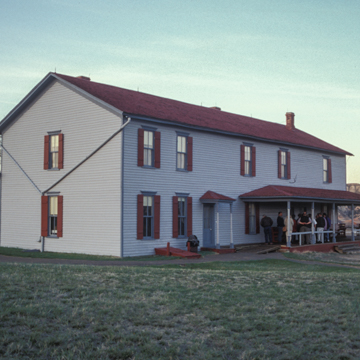The Marquis de Morès built the chateau to serve as the summer residence of the town’s founding family. With its twenty-six rooms, the chateau was an imposing feature of this frontier setting, where construction materials were scarce at best and had to be transported considerable distances. By introducing a touch of elegance to the still-raw and unpretentious settlement frontier, the chateau and its residents presented a sharp contrast to the austere way of life common to the region. With the decline of the de Morès enterprises, the marquis and his family returned to the East and Europe, leaving the Chateau de Mores to the care of a small staff. The rustic two-story frame frontier house that the de Morèses built does not fit the conventional notion of a French chateau. The exterior walls of milled siding are painted gray with slate-gray trim, and a covered veranda is supported by milled timber posts. The shingled gable roof and window shutters are red. The interior of the house, however, is extravagantly furnished with decor of the finest materials and genteel comfort. Many of the items were imported from Europe and the metropolitan trade centers of the East Coast. A WPA/CCC project restored the chateau to its 1885 appearance, and later conservation was undertaken by the State Historical Society. Local sandstone and timber entrance gateways and service buildings recall the role of the CCC in conserving the historic site. A modern interpretive center at the new entrance to the site is inspired by the design of the original chateau.
You are here
Chateau De Mores State Historic Site
If SAH Archipedia has been useful to you, please consider supporting it.
SAH Archipedia tells the story of the United States through its buildings, landscapes, and cities. This freely available resource empowers the public with authoritative knowledge that deepens their understanding and appreciation of the built environment. But the Society of Architectural Historians, which created SAH Archipedia with University of Virginia Press, needs your support to maintain the high-caliber research, writing, photography, cartography, editing, design, and programming that make SAH Archipedia a trusted online resource available to all who value the history of place, heritage tourism, and learning.


